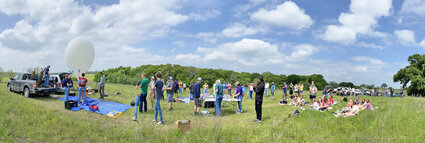South Dakota science students travel to Texas for eclipse study
April 17, 2024

Courtesy photo
On a hill on a large ranch just southeast of Dallas, schools and research groups from all over South Dakota converge to launch two weather balloons to a height of 35,000 feet carrying a diversity of payloads on everything from measuring atmospheric radiation levels to wind-blown biologicals.
by Spencer Cody
EC Science teacher
Seventeen Edmunds Central and Bowdle students and two teachers traveled by bus to view the eclipse in totality in Texas as part of an effort to increase each district's knowledge in space science and interest in space science careers.
This effort was funded through two Kelly Lane Earth and Space Science Grants made to each school funded through NASA via the South Dakota Space Grant Consortium.
Leading up to the eclipse, students in both schools worked on research and presentations concerning the space science surrounding the eclipse and related space science careers including safety issues concerning eclipse viewing using eclipse glasses. These students presented their research out to the remaining students in K-12 in each district.
On April 5 and 6 students and teachers from both districts traveled by bus to Texas. The group spent a day at the Johnson Space Center in Houston taking advantage of their eclipse programming they had the weekend before the eclipse in addition to all of the space exploration exhibits.
On the morning of eclipse day, April 8, the group traveled up from Houston to the Dallas area to a ranch near Combine, Texas, where we met up with other schools from South Dakota including Rapid City, Lower Brule, Spearfish, and School of Mines. Students from these schools were a part of a NASA research project that released weather balloons across the country throughout the path of totality. We were fortunate enough to be their guests through our work with the South Dakota Space Grant Consortium. The ranch we were at was perfect for launching weather balloons allowing our group to congregate on a hill above the surrounding terrain.
The weather forecast for North Texas for viewing the eclipse was pretty grim with extensive cloud cover predicted, but as we got closer to the eclipse, we became more hopeful that the skies were going to clear off, and they did...just in time! At first contact, the point when the moon first covers part of the sun, we launched the first weather balloon. At about 20 percent totality, we launched the second balloon. Both balloons carried payloads designed by students to take a variety of measurements of the atmosphere during the eclipse. In addition, the weather balloons were livestreaming their flight. We were tasked with tagging along in the pursuit of the second weather balloon launch to assist in its retrieval.
As totality on the hilltop came closer, the sunlight steadily dimmed while temperatures declined. The last 20 percent of the sun showed a marked decrease in sunlight and temperature. But, it was not until the last glimmer of the sun was covered by the moon, that we could remove our eclipse glasses and see the shimmering corona.
By chance with this eclipse, we were able to see remarkable prominences that just happened to be visible at that time in our viewing with their orange curls of atmosphere shooting off into space. Several planets and stars were visible during totality that were adjacent to the sun.
At one point someone from the crowd shouted for everyone to be quiet and listen to the wildlife. Sure enough, the crickets had started chirping along with other noises associated with the night. With one last encore, the moon and sun delivered a stunning diamond ring effect, and then it was over, and glasses had to go back on.
Once totality was over, our group started to pack up equipment to leave. Since we were going to pursue the second balloon that was launched, we would be coordinating with Lower Brule since the weather balloon contained their experiments. We left the ranch and drove a couple of hours to the northeast following the wind trying to estimate where it would come to a crash landing. The payload made it to an elevation of 35,000 feet before the balloon burst and sent its contents crashing back to earth. Unfortunately, satellite tracking showed us that the payload crashed into a bayou just northeast of Talco, Texas. Our two schools were not a part of the final recovery efforts that evening due to the difficult nature of the retrieval. It ended up taking volunteers, both local and from our cohort, every bit of remaining daylight to locate and extract the payload, which required walking through waist deep bayou water to get to the balloon about a half a mile from the nearest road.
Two of Lower Brule's experiments were potentially contaminated due to having their seals ripped open upon landing while a third remained closed. All three experiments were designed to measure particulates in the atmosphere for biological traces. Basically, the payload exposed petri dish surfaces at various points during the balloon flight capturing particulates that may carry bacteria and/or spores. The results of these experiments are ongoing and are currently being grown and analyzed in a lab.
We give a special thanks to NASA and the South Dakota Space Grant Consortium. This was a remarkable learning experience for both our school districts.


Reader Comments(0)